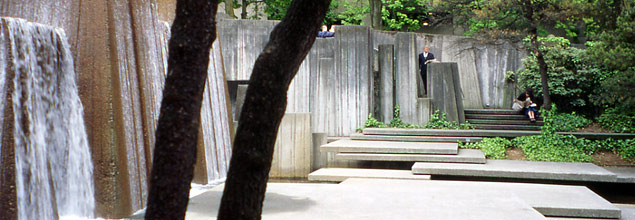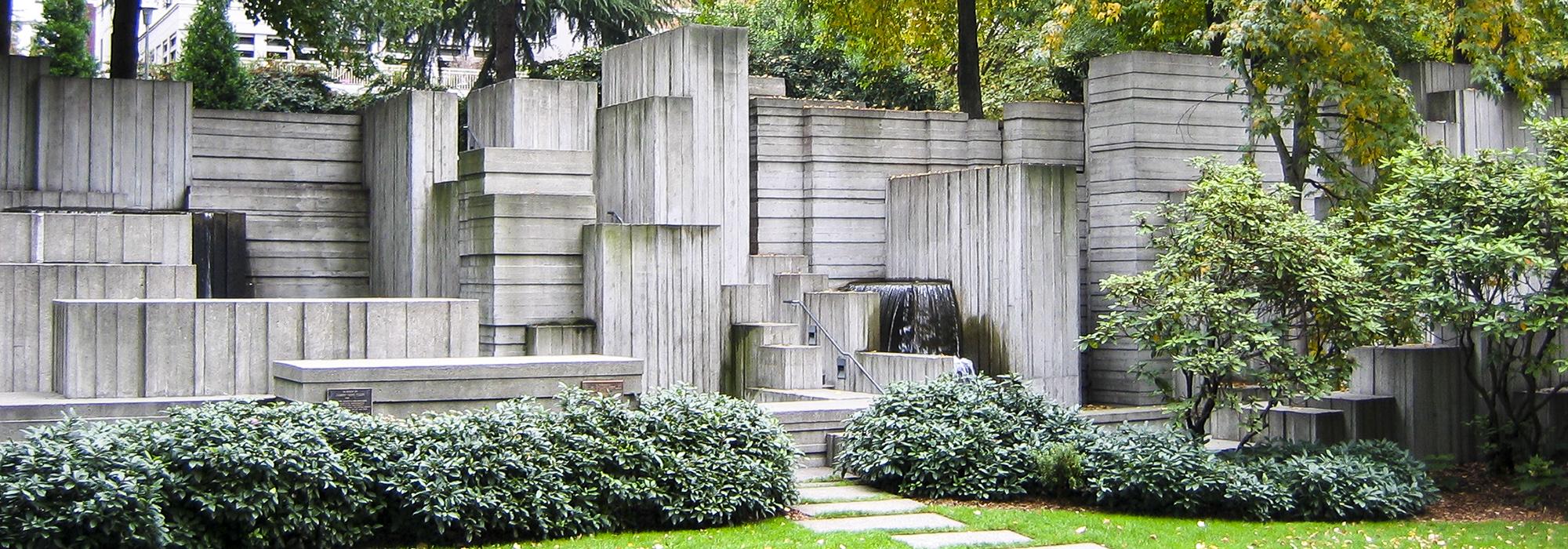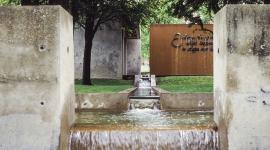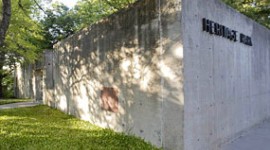Preserving the Modern Landscape

Views of Lawrence Halprin
In the past few decades the need for preservation and conservation of our diminishing natural resources has become a major national issue. We recognize the need to save and protect our natural resources and this important movement includes air, water, land, and biological species. Internationally, the urgency is even more apparent and has recently surfaced in the Kyoto Protocol and at the United Nations meeting in Johannesburg. These movements are dedicated to the preservation of our planet and our biological way of life. They are fighting against thoughtless destruction and a mind-boggling pace of change.
In the natural environment we have also recognized the importance of specific natural networks: we are restoring watersheds, river systems, and forest habitats. We want to protect them as well as make them available for hiking, boating, fishing, swimming, etc.
And still, we desperately need other types of preservation and conservation that affect our cultural as well as our environmental heritage. In the landscape of our cities, many important designed improvements, built since WW2, are beginning to come under attack by civic agencies and developers. Landmark quality buildings as well as plazas and parks are being torn down to accommodate larger developments. Lands set aside for open space are particularly vulnerable and are often sacrificed for freeways or commercial malls. The argument for acquiescing to demolition is often based simply on the fact that “change is inevitable and we just have to put up with it”.

The side effect of this point of view is that wonderfully designed open spaces are often sacrificed for what are perceived to be more “practical and needed” new facilities. What is particularly upsetting is that in the last few decades, the importance of cities and their public open space has undergone a roller-coaster of attitudinal changes. At times, life in cities has been thought to be undesirable and frightening. During those times, open spaces become targets of our fear —concrete is poured and high-powered lights are added to open spaces and parks. Presumably, this is done to make them feel safer.
Eventually, the pendulum swings and young people and empty nesters find their interest in living in cities renewed. They move back to cities partly to avoid long, and increasingly arduous, commutes. More importantly, they move back to enjoy the architecture, designed landscapes, streets, and open spaces, as well as the rich cultural and social life that cities offer.
The quality and character of all cities is dependent on design. This includes the design of buildings and, perhaps more importantly, the design of open spaces (streets, plazas, parks, river edges, etc.). These open spaces have been designed over time and all together are what we term landscape architecture.
The best pieces of landscape art and design are important not just as contemporary places to live in but as part of our history and culture. We travel to iconic places all over the globe and use them as touchstones for our culture and our memories. The difficult question is not whether we should protect and preserve the best of these designs, but which ones are the best. What is worth preserving and why! Not everything from the immediate past is worthy of preservation. How do we decide which works deserve to be preserved in our cultural landscape?
In the preservation of a major natural phenomena and its elevation to the status of a National Park or Monument, the choice is a Congressional one and based on specific criteria. But, when a smaller open space design is at stake, the selection has to be determined at a more local level. Here the issue is more complicated in a way, since the criteria is far more varied and subtle than the grand National Parks. In cities, plazas and pocket parks are often judged as if they are pieces of sculpture. Sometimes, they are historical. As a result decisions must be made with the assistance of a variety of specialists, art critics, elected officials, and other commissions.

In the “fine” arts, the processes by which decisions of cultural or artistic value evolve are very organic and almost imperceptible. Icons emerge slowly in literature, painting, music, and dance. In landscape architecture, however, critical issues often arise suddenly, and such decisions are often triggered by commercial agendas. It is therefore important to formalize a process for preservation that can react as quickly as the attack.
From my own experience, here are some of the more important values for making preservation decisions.
Status in a community is one important consideration in all decision-making. Central Park in New York and Golden Gate Park in San Francisco are clear examples of landscapes that are essential to the persona and life of these cities. In the case of Central Park, the design itself is exemplary. That, plus the fact that it was designed by one of our great landscape architects, makes it deserving of preservation. These two characteristics (status & exemplary design) should make a landscape at least worthy of consideration for preservation.
At its best, landscape architecture is an art form whether it is produced by a major designer or an unknown one. Therefore, a panel of art critics needs to be involved in preservation determinations.
Additionally, a project, which performs a major regional function (such as transforming the edges of a river or a bay), can transcend other considerations and demand preservation simply for the life enhancing qualities that it confers on a place. A unique example of a particular landscape type or environmental/ecological character (such as a wetland or bird habitat) also deserves to be preserved for the same reason.
Finally, examples of different aesthetic periods also deserve to be preserved, as they are physical representations of a historical period in landscape design. Charles Birnbaum’s book, Preserving Modern Landscape Architecture provides a valuable study of this issue, particularly as it relates to modern landscape design. There are, however, other important periods and categories that must be considered as well.
The problem of deciding what is valuable enough to be preserved within the modern whirlwind pace of change is daunting. A major part of the solution has to start with educating the public about the importance of designed landscapes. This education should begin at an early age and include the elements that form a critical eye for judgement of the values of environment and landscape design.
As with all art forms there is always a variety of opinions about what constitutes the essence of the art of landscape design. What differentiates our art is that it is multidimensional, based as it is on the physical experience of moving through the landscape. As we move, all of our senses are engaged: we become aware of colors, smells, sounds, and the feel of earth and stone underfoot. The emotional impact of water in pools, streams, and waterfalls tugs at us consciously and subconsciously. No other art form designs with so many elements of nature, whose experiences are often extremely ephemeral. The enjoyment of landscapes is primarily experiential. That is another reason why special critical judgement is needed to evaluate the worth of these designs and decide what should be preserved.
Some of my own experiences with preservation in the past few years have been excruciatingly painful. Much of this, of course, comes about because my practice has extended over a period of 50 plus years. Things have changed a great deal over that period of time. Many of my early work in cities were designed for conditions that have been vastly modified. My work in the sixties and seventies was built during the urban redevelopment period when large swathes of “ghetto” areas were demolished. These early attempts to make major improvements in the environment of urban housing were considered mandatory at the time. Since then, of course, policy and approach have changed. Cities, streets, plazas, and parks, which were designed in revolutionary ways, are now under attack for not solving the requirements of modern downtowns with their emphases on commercialism.
In the meantime, a number of my projects have been subjected to redesign. Usually, without my involvement in the redesign and rebuilding, the character and quality are forever changed. Some of this is actually being attempted as I write this essay. Usually, this process is not polite. In most cases I feel there is a great loss to the communities for which they were built.
When people in these communities have asked for my involvement, the bureaucracies have often suggested that I “would be too busy,” or “would resist any changes,” or worse, “wouldn’t be interested.”
To a certain extent I feel that things are changing for the better. More and more citizens have become interested in their environments and they want a stronger voice in their affairs. More and more people have become aware of the role that landscape design plays in their lives. In my own lifetime understanding about our design profession has changed greatly and its role as an art form is now appreciated.
Ultimately, a great part of educating the public about landscape design lies in empowering them and making them aware of their civic role in planning and protecting their physical surroundings. This can be a heavy responsibility but it can also be an expansive one. We have good role models to follow in the larger environmental movement. We can learn from them and interact with like-minded groups to bring attention to this need for thoughtful preservation of the best examples of this life enhancing landscape art form.





